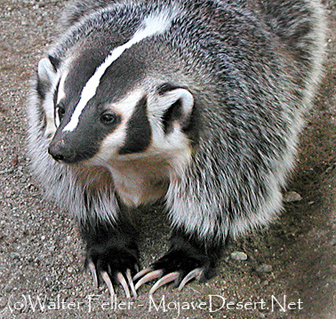American Badger
The American badger (Taxidea taxus) is a North American mammal known for its distinctive appearance and burrowing behavior. Here are some key characteristics and information about American badgers:Appearance:
The American badger has a stocky and low-slung body with short legs. Its fur is coarse and ranges in color from gray to brown, with a white stripe running from its head to the base of its tail. The face typically has black markings, including distinctive black patches on the sides, resembling a mask.Habitat:
American badgers are found in a variety of habitats, including grasslands, prairies, deserts, and open woodlands. They prefer areas with loose, well-drained soil, as they are skilled diggers.Behavior:
Badgers are primarily solitary animals. They are nocturnal or crepuscular, meaning they are most active during the night or at dawn and dusk. Known for their digging abilities, American badgers create burrows to live in and often use them for shelter and raising their young.Diet:
Badgers are carnivores and have a diverse diet that includes small mammals like rodents, ground squirrels, and rabbits. They are also known to eat birds, bird eggs, insects, and sometimes carrion.Reproduction:
Breeding usually occurs in the late summer or early fall, with a gestation period of about six weeks. Female badgers give birth to a litter of one to five cubs in the spring. The cubs remain with the mother for several months before becoming independent.Conservation Status:
American badgers are not currently considered endangered or threatened, but their populations can be affected by habitat loss and fragmentation.Role in Ecosystem:
Badgers play a role in controlling rodent populations, and their digging activities can help aerate and turn over soil. It's important to note that while badgers are generally not aggressive towards humans, they can be territorial and may defend themselves if they feel threatened. Observing them from a distance is recommended in the wild.- Feller
American Badger Taxidea taxus
Family: Mustelidae Order: Carnivora Class: Mammalia
DISTRIBUTION, ABUNDANCE, AND SEASONALITY
Uncommon, permanent resident found throughout most of the state, except in the northern North Coast area (Grinnell et al. 1937). Most abundant in drier open stages of most shrub, forest, and herbaceous habitats, with friable soils.
SPECIFIC HABITAT REQUIREMENTS
Feeding: Badgers are carnivorous. They eat fossorial
rodents:
rats, mice, chipmunks,
and especially ground squirrels and pocket gophers. Also eat some
reptiles,
insects,
earthworms, eggs, birds, and carrion. Diet shifts seasonally and yearly in response to
availability of prey.
Cover: Badgers dig burrows in friable soil for cover. Frequently reuse old burrows,
although some may dig a new den each night, especially in summer (Messick and Hornocker
1981).
Reproduction: Young are born in burrows dug in relatively dry, often sandy, soil, usually in
areas with sparse overstory cover.
Water: No data found.
Pattern: Suitable habitat for badgers is characterized by herbaceous, shrub, and open
stages of most habitats with dry, friable soils.
Activity Patterns: Active yearlong. Nocturnal and diurnal. Variable periods of torpor in
winter (Long 1973).
Seasonal Movements/Migration: Non-migratory. Area used during winter smaller than at
other seasons.
Home Range: Home range estimates vary geographically and seasonally. In Utah,
Lindzey (1978) found fall and winter home ranges of 5 females varied from 137-304 ha
(338-751 ac). Those of 2 males varied from 537-627 ha (1327-1549 ac). In Idaho, Messick
and Hornocker (1981) found that home ranges of 7 adult females and 3 males averaged 160
ha (400 ac) and 240 ha (600 ac), respectively.
Territory: Little information available. Family members may share the territory of a female
(Seton 1929). However, males generally are solitary, except in the breeding season (Messick
and Hornocker 1981).
Reproduction: Badgers mate in summer and early fall. Gestation period varies from
183-265 days, including delayed implantation. Embryo implants about 45 days prior to birth.
An average litter of 2-3 (range = 2-5) born mostly in March and April (Long 1973). A few
females may breed in first yr. Males not mature sexually until second yr. Badgers 11-15 yr.
old have been reported (Flower 1931, Jackson 1961, Long 1973, Messick and Hornocker
1981).
Niche: Badgers are highly specialized fossorial mustelids that help control small mammal
populations. Somewhat tolerant of human activities, however predator control using
indiscriminate trapping and persistent poisons causes extensive losses.
Source:
CDFW California Wildlife Habitat Relationships. Accessed [N/A]
https://wildlife.ca.gov/Data/CWHR


Carnivore - Predator - Diurnal / Nocturnal
Badger
Taxidea taxus jeffersoni
Badgers are nocturnal, but have been seen active during the day as well. Badgers commonly feed on mice, woodrats, kangaroo rats, ground squirrels and pocket gophers. They also will eat fish, snakes and lizards.
Badgers enlarge and dig out burrows in pursuit of prey. Badgers have been observed to plug accessory entrances to burrow systems, presumably to trap prey within the burrow. They also dig into a burrow from the "back entrance" and then lurk in the main entrance, capturing prey as it enters the burrow.
The badger is an aggressive animal and has few natural enemies. There are reports of predation on badgers by golden eagle, coyote, cougar, and bobcat.
Wide open plains and deciduous woodlands are the principal habitats occupied by the American badger, but across its range a wide variety of habitats are utilized, and the species can also be found in mountainous areas marshy areas, prairies and deserts.
|
The Desert Food Chain * Everything has its niche. Who eats what, and what eats who in the desert? Click here to find out what more. |
Saddleback Butte
...and the occasional badger or ...
Death Valley > Mammals > Cats & Others
...Mostly nocturnal, but often active in early morning...
Joshua Tree > Mammals
...scarcity of food in the desert limits the number of large mammals that can...